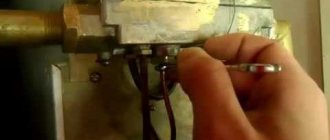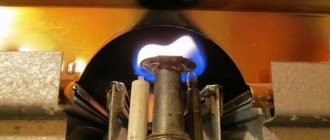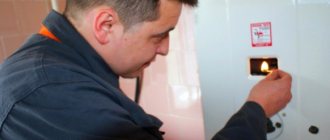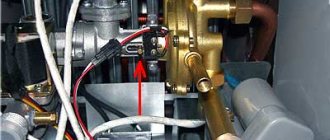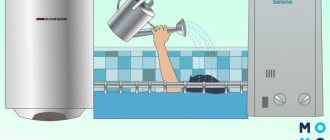You can determine why the gas water heater goes out and fix most problems in the water heater yourself.
Malfunctions are manifested in the following:
- the flame goes out immediately after switching on;
- the column goes out during operation;
- attenuation occurs when switching to the “shower” mode or mixing hot water with cold;
- the burner continues to work after turning off the water.
In each of the described cases, malfunctions are caused by different reasons.
Features of the device and principle of operation of the gas burner
Gas burners are designed for uniform combustion of the supplied fuel. Depending on which room will be heated, the burner is selected. There are two main types: household ones, which have low power, so they are great for an apartment or private house. Industrial ones are more powerful and are well suited for heating industrial, industrial premises and boiler rooms.
Depending on the fuel used, the type of burner is selected.
The principle of operation of a gas burner is as follows. Air is mixed with fuel, forming a gas-air mixture, which is supplied to the combustion chamber, and the combustion process is already supported there.
In fact, the process can be divided into three stages, which occur much faster than described.
- Preparatory. At this stage, the required amount of fuel and air is supplied, which acquire their speed and temperature.
- The connecting stage speaks for itself. The required amount of fuel is supplied and mixed with air, forming a combustible mixture.
- The combustion itself. When the elements are mixed, a combustion process occurs, which is subsequently maintained.
What does a gas water heater look like?
Many modern gas burners and boilers are equipped with automatic instrumentation that monitors the combustion process and constantly supports it. And the process itself does not pose any danger. In the event of a gas leak or dangerous situation, the automation stops the fuel supply.
What other reasons are there for extinction?
Failure of the gas water heater can also be caused by these elements.
Outdated membrane
The polymer material from which the membranes are made has sufficient elasticity, but after many years of use it disappears and the element becomes rigid, and it is possible that cracks or lime deposits may appear in it. Such defects will not allow the gas water heater to work regardless of how the tap is opened. Therefore, it is worth removing and inspecting the membrane: if its condition causes concern, a replacement for this element should be found as soon as possible.
Ignition system and piezo element
In devices that do not have an igniter, its functions are performed by electronic ignition, where the spark is generated by batteries. Perhaps the fault lies with them, since they are not always able to work for a whole year. In other geysers, a piezoelectric element driven by a water turbine is responsible for producing a spark. Such an ignition system will not help if the water pressure is low.
A regular igniter is also at risk of clogging; this can be easily determined by the yellow color of the flame. If the burner ignites with a loud bang, this is your case. After cleaning the element, everything returns to normal.
The shower turns on - the speaker goes off
If the water heater only turns off when the shower is turned on, then it is entirely its fault. The reasons may be:
- The mesh filter installed in the shower head is clogged.
- When the watering can becomes clogged, the water pressure decreases. You can try to unscrew it. If the column starts working, the reason has been found.
- The inner rubber pipe of the hose has become twisted, blocking the flow of water.
Signs of igniter malfunction
Many owners of gas boilers have noticed that sometimes the igniter does not work for a long time or it needs to be lit manually. The problem mainly lies in the automation. Oddly enough, what is supposed to prevent accidents and causes problems with flames.
Most boilers are equipped with a EUROSIT630 sensor, which stops the gas supply if there is a danger of leakage or explosion. But in reality the problem lies in the following:
- The wick jet is clogged and needs to be cleaned. But if you are not well versed in gas equipment, we recommend calling a specialist. It will be safer this way.
- The thermocouple has burned out. Therefore, the automation extinguishes the entire wick. It needs to be replaced. Also by calling a specialist.
It is easy to solve both problems on your own or by the gas service. If you have no experience in repairing gas equipment, it is best to contact specialists.
Typical problems
Let's look at why the gas water heater goes out.
Attenuation can be caused by a number of reasons. A sensor may turn on and detect a gas leak. There may be problems with the operation of the chimney. A clogged igniter will also often cause damping problems. Sometimes the automation fails. Often the problem of attenuation is also related to the quality of the fuel. Some gas facilities do not supply pure gas, but diluted gas. Such low-quality fuel is easily identified by the orange color of the flame. If serious automatic protection systems are installed in the column, they will turn off the system
It is also worth paying attention to gas leaks. Even minor leaks are the reason why these units fail
Repairing geysers at home can help. But you should only turn to professionals - gas is not something to joke about.
Reasons why the wick goes out
The problem of a dying wick is especially relevant when this happens constantly and it is impossible to light it manually. Let's look at all the cases. First of all, you need to decide when the burner goes out, whether there are any extraneous sounds, smells, etc.
When you turn on the gas water heater
In the first case, the problem is most likely with the ionization sensor. It is responsible for maintaining the flame in the burner. You can understand that the problem really lies in the sensor by the following signs:
- Burning occurs only for a few seconds, usually no more than 5 seconds.
- With each subsequent launch the performance improves. It even works for some time. But then the problem arises again.
To solve this case, you need to check the wiring to the sensor; if everything is fine with it, you should replace the part itself. It would be more correct and safer to contact specialists or those who understand the operation of gas equipment.
In progress
The second case of wick fading occurs when it is operated for a short time. The main reasons may be:
- Bad traction. Soot accumulated in the chimney, debris got in, and birds began to build nests. Determining the presence of chimney draft is very simple. You just need to bring a match or lighter to the window through which it goes out and turn on the boiler. If there is a deviation of the flame, then the reason for the fading of the wick is something else. If the fire does not flutter, there is no draft. The flue gas pipe must be checked.
- The heat exchanger needs to be cleaned. It may happen that it is covered with scale or soot. These problems lead to overheating of the heat exchanger and also prevent it from operating in stationary mode.
- No natural ventilation. Therefore, it is so important that the room in which the boiler is installed has a window or an opening window.
- There may be strong ventilation nearby to prevent the wick from burning. In this case, it should be turned off when the boiler is operating or reduced to minimum.
- Another interesting case could be a piezo ignition column. that is, using the ignition button. For it to work, you need to hold it for at least 10 seconds. That is, the issue may not be that the burner is broken, but rather its correct use.
Poor draft is the reason why the wick in a gas water heater goes out.
If you don’t find yours in the above reasons for the wick going out, then you should contact the company. With whom you have a contract.
Reasons for column attenuation after ignition
When identifying the cause of a malfunction, it is important to pay attention to two points: how the igniter goes out (are any extraneous sounds heard); this happens immediately after ignition or already during the combustion process.
Reason #1 - failure of the flame ionization sensor
If the device turns on and goes out, the ionization sensor is 70% to blame.
This element is constantly in contact with the flame. The ions produced during the combustion process are attracted to the sensor and produce a current. If there are enough ions, the device works. If there are few of them, the column does not function.
The ionization sensor is a thermocouple that is heated by a flame. It is also called a gas sensor because it prevents the device from leaking when the burner is turned off
Signs of malfunction:
- the burner went out 3-5 seconds after ignition;
- when restarted, the device operates longer;
- You just need to start the device several times and it is already functioning normally;
- problems appear only after a long break.
It is necessary to inspect the wiring that runs from the part to the control board. Why do we check all contacts? Then unscrew the holding screws and place the heating electrode at the hottest point of the flame.
This technique can extend the life of the sensor by another year. If everything is in order with the contacts and connections, the element needs to be replaced.
Reason #2 - the membrane of the water unit is worn out
A polymer part must have sufficient elasticity. Over time, this property is lost - the element becomes hard, cracks, and becomes overgrown with scale.
A water block or “frog” is a fairly simple device. The cover is held together with screws, by unscrewing which you can get to the membrane
If the element becomes unusable, the heater will go out. It is necessary to inspect and replace the membrane, if necessary, with a more durable silicone one.
Reason #3 - the wick is clogged with dust
In models with an igniter, this part often becomes clogged. The flame becomes weak and a yellow tint appears. But a change in the color of the flame may also indicate a lack of air in the gas-air mixture.
The result is that the device is either completely unable to ignite the burner, or performs its function after a large volume of fuel has been supplied. In the latter case, a characteristic bang is heard.
To clean the element you will need two screwdrivers (Phillips, slotted) and an adjustable wrench.
The algorithm is as follows:
- We remove the case - pull out the adjustment knobs, unscrew the bolts in the corners from the bottom, lift and remove the cover.
- We unscrew the draft sensor tube and the one that supplies fuel to the wick.
- We unscrew the screws and disassemble the structure.
- We clean the nozzle, blow out the tee, and assemble it.
There may also be a blockage in the draft sensor, which causes the igniter to smoke. After removing dust and dirt, the pilot light should burn with a stable blue flame.
After cleaning, the device may make a slight noise. The sound is produced by air that is sucked in through the slots in the wick guide housing. There is no danger, but the noise can be eliminated if you slightly tighten the wick with screws
If desired, all parts of the structure can be washed. But don't forget to dry them well before assembling.
Troubleshooting Tips
Not all reasons for malfunctioning burner operation are listed. Let's figure out what to do if the burner suddenly goes out and so on:
- If the pilot light constantly goes out, you most likely need to check the automation and thermocouple.
- If the main burner does not work, it may be due to low water pressure. The membrane needs to be replaced.
- If there is no spark from the igniter, the problem may be that the wiring from it is disconnected. Because of this, the necessary electricity is not provided.
- It is important to monitor the presence of traction. If it is absent, no flame will be observed.
If you cannot identify the problem yourself or none of the above methods work.
It is best to call a specialist who will carefully check the boiler and burner, identify the cause and tell you how to fix it. Yes, this may turn out to be expensive, but this way you won’t have to worry about finding the causes of the breakdown and be afraid of ruining the device, thereby dooming yourself to buy a new one.
What if the equipment is still noisy?
If, after these manipulations, the gas water heater still ignites with a bang when you turn on the water, then it is better to stop further independent research. In such situations, you will have to seek help from qualified specialists.
They will carry out competent diagnostics of the equipment, will be able to clearly determine what is causing the cotton and, based on the data obtained, will be able to provide you with options for solving the problem.
In certain cases, independent repair is impossible, then cooperation with qualified specialists will be a rational solution.
Preventive measures
Any equipment requires comprehensive care and inspection. Because it is subject to wear and tear during constant operation. To avoid constant breakdowns, calling specialists or even replacing the water heater or gas burner. Here's what you need to do to ensure a longer device life:
- Gas equipment must be serviced once a year while the warranty card is valid. And when the coupon expires - once every six months.
- To receive maintenance services, an agreement is concluded with the company that installed the boiler.
- The company usually checks the chimney, automation and leaks.
- If you smell gas and suspect a leak, you can check it yourself. Cover the suspected leak area with soap and water. If there is a leak, additional bubbles will appear. In this case, you need to turn off the gas supply and call the gas service. It is not advisable to use electrical appliances. We also advise you to leave the premises.
Preventative measures include maintenance once a year.
Of course, it is always necessary to follow all safety precautions when using a gas burner.
A gas burner is a convenient device for producing a flame by mixing air and fuel in the required proportions. But there are times when there is no flame. They do not depend on the imperfection of the device, but on improper care, manufacturing imperfections, and so on. It is always important to remember that if you have problems with the burner, you should contact a specialist.
How to prevent breakdown
To extend the life of the equipment and ensure its uninterrupted operation, preventive measures should be systematically carried out:
- clean the chimney;
- replace ignition batteries;
- remove scale and soot from instantaneous water heater components;
- Ensuring good air ventilation in the room is important not only for the normal functioning of the device, but also for the safety of people.
Timely cleaning and replacement of old filters will help avoid troubles associated with the operation of the water heating unit.
Is it possible to turn on cold water when the water heater is running?
Doing this is strictly not recommended for several reasons:
- Manufacturers prohibit turning on cold and hot water at the same time, as stated directly in the operating instructions. You need to initially set a comfortable temperature that allows you to do without mixing. Opening the cold water tap affects heating and causes rapid failure of the water heater.
- The main reason why you cannot turn on cold water when the gas water heater is operating is that this malfunction leads to a rapid build-up of scale in the heat exchanger.
For ease of use, modern automatic gas flow-through columns have a “winter-summer” mode. The function helps to quickly change the heating temperature and reduce gas consumption.
Rules for turning on gas water heaters
How to turn on an old speaker with matches
There are two main types of water heaters, differing in the ignition device. All models, without exception, are equipped with an ignition wick that burns constantly. The first residents of “Stalinka” and “Khrushchev” buildings had to use a column with levers. Later, water heaters with a built-in piezoelectric igniter appeared.
You should use an old-style geyser with caution. Failure to comply with the rules described in the operating instructions can cause an explosion, gas leakage and equipment failure. When turning on a instantaneous gas water heater, observe the following rules:
- Checking the presence of draft - before turning on, you should make sure that carbon dioxide can freely leave the room. Air circulation is checked using a strip of paper or a lit match. There is an inspection hole in the column body. A sheet of paper brought to it should adhere to the body of the water heater. The flame should be pulled into the hole.
Lighting up an old gas water heater is not that difficult. Switching off is carried out in the reverse order. First, the main burner is turned off, after which the water is turned off.
How to light a column with a piezo element
Classic speakers with control via levers have been replaced by models with mechanical switches in the form of knobs. The housing provided a piezo ignition of the wick, allowing the gas water heater to be ignited without matches. The ignition procedure is as follows:
- The electric valve is clamped - usually 15-20 seconds are enough for enough gas to accumulate on the wick for ignition.
- You will need to press the piezoelectric element 2-3 times. When the module is correctly positioned and in working order, it is enough to “click” the piezoelectric element once to ignite the wick.
Further steps are the same as in the case of a column lit by matches. If the piezoelectric element malfunctions, ignition is carried out using matches.
How to light a column with electric ignition
Those who have used automatic gas instantaneous and storage water heaters know that the user does not need to carry out complex manipulations, as is the case with old-style models. Modern gas water heating equipment is equipped with an automatic system that gives a signal to turn on when the hot water tap is opened.
The spark appears due to the activation of automatic ignition, powered by batteries or mains electricity. If the water heater is in good working order, a few seconds are enough for the burner to start and hot water to be supplied to the consumer.
Insufficient pressure
It often happens that the speakers light up, continue to work for a while, and then turn off.
- The first recommendation is to check the settings thoroughly. Perhaps the user himself chose the option to automatically turn off after some time.
- Another reason is an increase in temperature to 100 degrees or more. In this case, the temperature sensor is triggered and prevents further operation.
- Problems may arise due to poor pressure in the water or gas pipeline.
- Another possible reason is poor contact between the thermocouple and the solenoid valve.
In the latter case, simply cleaning the contact area is sufficient. The connections are further tightened.
There are other possible reasons why the gas water heater turns off.
- Oxidation of power supply contacts.
In this case, the device clicks, but the wick simply does not light up. The contacts require cleaning.
- Dead batteries.
It is recommended to replace these parts every six months. It is better to choose powerful batteries that can maintain a charge level for a maximum time.
Conclusions and useful video on the topic
How a geyser works: the principle of operation of the device:
How to correct the position of the flame adjustment sensor:
Analysis of two not obvious reasons why a geyser can turn on and immediately go out:
How to diagnose a problem by removing the heater casing:
The main problems with heater damping are listed. In most cases, they do not depend on the device model or manufacturer. Some you can handle on your own. But if you are not sure about this, it is advisable to contact a service center or gas service.
Would you like to talk about your personal experience in diagnosing the cause of speaker attenuation and how to repair it yourself? Or do you have questions that we did not cover in this material? Write your comments, participate in the discussion - the feedback form is located below.
Electronics malfunction
The draft sensor in geysers is usually located on top. It is attached to the chimney.
Modern geysers have many electronic units and sensors on board - only the simplest models do not have them. Sensors monitor draft and the presence of flame (ionization control), monitor the water temperature and automatically regulate the degree of its heating. If one of the sensors fails, the gas water heater will malfunction. The most typical malfunction is a breakdown of the draft sensor in the exhaust gas manifold. As a result, the electronics will not give the go-ahead for ignition.
Failures also occur in electronic modules installed in many geysers. Repairing them is complicated by the fact that this requires special knowledge in the field of electronics and circuit design. If you are sure that electronic components are faulty, but do not have the necessary knowledge, feel free to call a specialist.
Troubleshooting new equipment
New equipment may also experience various problems. Most often they manifest themselves in the operation of the flow sensor, in the operation of the candle, or in the power system. Let's take a closer look at these problems.
Column microswitch failure
Often the problem with a loud bang during ignition is the insufficient discharge of batteries, which provokes the inability to instantly ignite the gas-air mixture.
The power supply is connected to the control unit via special microswitches, which are responsible for generating a signal to activate the ignition when the DHW tap is opened. If the signal arrives at the wrong time, this causes the problem. This malfunction occurs most often due to oxidized contacts. The microswitch cannot be repaired; it will need to be replaced.
If the microswitch breaks down, repairs cannot be carried out, since this system will have to be completely replaced
Flow sensor malfunction
Often the problem with popping is the flow sensor. It is located in the input circuit. A signal is sent to the control unit controller indicating the presence of liquid in the pipe. The data instantly activates the ignition system. Intensive use of this element creates an increased risk of breakdowns. For example, contact groups can be oxidized.
Such sensors are most often manufactured in a non-separable design, therefore, if a problem occurs, they cannot be repaired and must be replaced.
Working candle offset
The problem may be with the spark plug. After applying voltage, it provokes the formation of an electric spark. Modern candles are made in such a way that they can last for a long time. Element failures are rare, but they do happen.
The most common occurrence is that the ignition device is displaced relative to its nominal position. It can occur as a result of repeated heating and cooling. Such processes are associated with changes in the dimensions of individual structural elements. As a result of adjusting the position of the spark plug, the spark parameters become normal, and extraneous noise completely disappears.
Incorrect operation of the ignition retarder
A rare breakdown is considered to be incorrect operation of the ignition retarder. When disassembling the column, you need to remove the water regulator. On its cover there is a hole in the bypass channel, in this hole the ball is located. The adjusting screw determines the position of the ball.
If, when shaking the lid, you hear the sound of a moving ball, then you should not manipulate this part further. If there is no knocking, then you can move the ball using a thin copper or aluminum wire through the passage channel hole, which is located in the regulator cover.
Most often, the retarder is a ball of metal or plastic that blocks part of the bypass channel in the water regulator. In most column designs, this moderator is located in the boss of the water regulator cover.
As a last resort, you will have to resort to the procedure of parsing the element. It must be said right away that the external screw does not affect the position of the ball in any way.
The inner screw must be removed very carefully. You should first remember its initial position, and also clearly determine the number of revolutions by which this screw is screwed in
This will allow you to maintain the required location of the element (ball) during subsequent assembly.
After repair work, be sure to check all connections to completely eliminate leaks of both water and gas. All connections must be treated with a sealant to ensure tightness. After which you can put the casing in place and use the column as usual.
Checking the column solenoid valve
If the help of a paper clip does not help, check if the solenoid valve, which has a resistance of approximately 0.2 ohms, is working. They check it in the following way: apply a voltage of 20-30 mV to the winding at a current of 100 mA. This mode is easily created by any AA battery or battery and 100 m resistor. Light the wick and remove your hand from the gas control knob. The wick should continue to burn. When the battery is disconnected, the flame should go out. If these conditions are met, it means that the solenoid valve is working. Hence the conclusion: the thermocouple is broken. If you cannot find a short circuit or bad contacts by external inspection, it is recommended to replace the thermocouple.
Elimination of traction disorders
To test traction, try using an ordinary match. Bring it to the chimney and determine if there is a draft, then the flame will deviate towards the chimney.
If there is no draft, the gas water heater will not light and users will not receive hot water. Many dispensers are equipped with draft sensors, and if they show insufficient draft, ignition will be impossible. Situations are possible when the flame lights up and immediately goes out - this is due to the fact that the combustion products simply have nowhere to go, they remain in the combustion chamber, and the flame goes out due to lack of oxygen.
Lack of draft will require an inspection of the flue gas collector and the chimney itself. If there are blockages here, they can interfere with the normal passage of combustion products. The column perceives this as a lack of traction and does not allow the gas to ignite (or the gas goes out immediately after turning on). Unfortunately, you will be able to independently check only the part of the chimney that is visible before entering the wall - further work must be carried out by specialists . If the house is private, you can try to figure out the chimney yourself.
Other sources of the problem
Let's look at other problems that cause the problem of column attenuation after ignition.
The fading of the wick may be due to the presence of powerful ventilation near the column. Exhaust air is drawn into the ventilation, which leads to attenuation. It is necessary to turn off the ventilation or turn its power down to minimum while the gas heater is operating.
For the same reason, you should not place a powerful hood next to the column. During its operation, sensors may be triggered, diagnosing a malfunction.
Sometimes the reason is hidden in the lack of natural ventilation. It is necessary to open the window or install a supply valve.
The wick can also be extinguished in models with piezo ignition. The button must be held for at least 10 seconds.
Also, during operation of the heater, it is not recommended to mix hot and cold flows. This leads to a drop in pressure in the line and damping of the wick.
The problem is solved by adjusting the indicators to a comfortable level and reducing the pressure with a special handle. If you still have to mix water, you need to leave the hot stream as the main one.
Attenuation may be caused by a malfunction of the solenoid valve or servomotor. Only calling a specialist will help here.
Why does the Neva gas water heater not work?
The Neva column does not light up due to the batteries being discharged. As a rule, this may be the case with automatic ignition. In order to get rid of the reason for the Neva gas water heater not igniting in this case, it is enough to simply change the batteries; If you have low water pressure at home, the Neva water heater will not light up.
Interesting materials:
How to transfer a website from hosting to another? How to transfer saves from Fallout 4? How to move a selected area to a new layer? How to transfer a motorcycle to a new owner? How are checks processed? How to transplant a flower into a pot without holes? How to calculate agar strength? How to send from messenger to WhatsApp? How to reinstall Viber and save correspondence? How to flip the screen on Lenovo Yoga?
